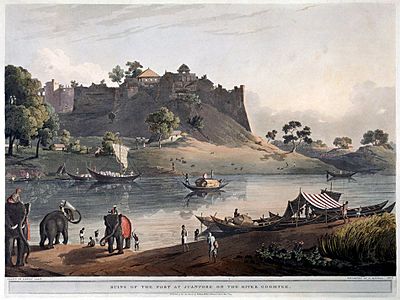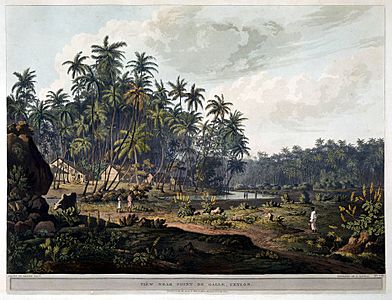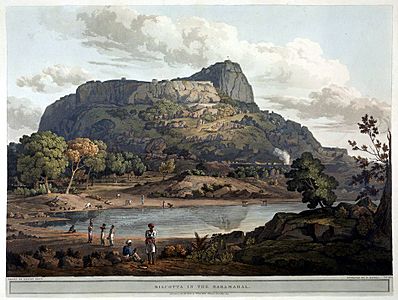Henry Salt (Egyptologist) facts for kids
Henry Salt (born June 14, 1780 – died October 30, 1827) was an amazing English explorer, artist, and diplomat. He loved collecting ancient treasures and became a famous Egyptologist, someone who studies ancient Egypt.
Contents
Biography
Early Life and Art Dreams
Henry Salt was born in Lichfield, England, on June 14, 1780. He was the youngest of eight children. As a young boy, he went to school in Lichfield and Birmingham. He was very interested in drawing and painting portraits. He studied art in London with famous artists like Joseph Farington and John Hoppner. However, he found it hard to become a well-known portrait painter, so he decided to try something new.
Exciting Early Travels
In 1802, Henry Salt got a job with a rich English nobleman named Viscount Valentia. Salt became his assistant and artist for a big trip to the East. They sailed on a ship from a large trading company to India, stopping at the Cape Colony in South Africa.
Salt explored many places, including the Cape of Good Hope, India, and the Red Sea area. Viscount Valentia saw how good Salt was at drawing all the amazing sights they saw.
In 1805, Salt went on a special journey into Ethiopia (which was then called Abyssinia). His mission was to meet a local leader named Wolde Selassie to start trade between England and Ethiopia. Salt earned Wolde Selassie's respect during his visit. He returned to England in 1806, traveling through Egypt where he met the ruler, Mehmet Ali.
Salt's drawings from this trip were used in Viscount Valentia's book, Voyages and Travels to India.
Salt returned to Ethiopia in 1809 for another government mission, hoping to build more trade and friendships. He couldn't meet the king because of problems in the country, so he stayed with his friend Wolde Selassie. During this trip, Salt also checked and corrected information about the region from an earlier Scottish traveler.
In 1811, Salt came back to England with many plant and animal samples. He even discovered a new type of small antelope called a dik-dik! In 1814, he published his own book, A Voyage to Abyssinia, which described the culture, land, and customs of Ethiopia. He also released a collection of drawings from his travels.
Becoming Consul General in Egypt
Because of his book and amazing explorations, Henry Salt became well-known in the British government. In 1815, he was chosen to be the Consul General in Egypt. This meant he was the top official representing Britain in Egypt.
He arrived in Alexandria in 1816 and then moved to Cairo, where he would live. His main job was to find and collect ancient Egyptian treasures for the British Museum. To do this, he knew he needed to be friends with Egypt's ruler, Pasha Mehmet Ali.
Salt was very good at building strong relationships between the British government and Ali. He helped them talk and make agreements about trade and land. This made Ali like him a lot. In return, Ali gave Salt a nice home in the city and a place in his court.
Salt also helped pay for important digs at ancient sites like Thebes and Abu Simbel. He even did his own research at the pyramids of Giza and the Great Sphinx. He was praised for his skill in understanding hieroglyphs, the ancient Egyptian writing. In 1825, Salt published his own book about how to read hieroglyphs.
During his time as Consul General, Salt worked hard to gather a huge collection of ancient items. Another collector, Bernardino Drovetti, who knew Egypt very well, tried to stop him. But Salt didn't give up! He hired his own helpers, including Giovanni Battista Belzoni and Giovanni D’Athanasi. Thanks to their help, Salt was able to start selling his amazing finds in just two years.
Death
Henry Salt passed away in Egypt on October 30, 1827, at the age of 47. He was buried in Alexandria. His paintings, papers, and the many ancient treasures he collected are now kept at the British Museum.
Years later, in 1849, a type of flowering plant from Yemen and Saudi Arabia was named Saltia in his honor.
Work and Contributions to Egyptology
Collecting Ancient Treasures
Henry Salt put together three main collections of ancient Egyptian artifacts during his life.
His first collection, gathered from 1816 to 1818, was valued at a lot of money when it arrived in England. In 1823, the famous sarcophagus (a stone coffin) of Seti I from this collection was bought by an architect named Sir John Soane. The rest of the collection was bought by the British Museum.
Salt then started his second collection, from 1819 to 1824. He hoped the British Museum would buy it and give him a yearly payment for his work. However, the museum thought it was too expensive. But the French royal family wanted the collection for the Louvre museum in Paris! They bought it in 1826 for a very large sum of money.
Salt spent the rest of his life creating a third collection, from 1825 until his death in 1827. This final collection was sold to the British Museum after he passed away.
Famous Artifacts He Found
Henry Salt helped discover or acquire many incredible ancient Egyptian pieces, including:
- The head of Ramses II (also known as Young Memnon)
- The sarcophagus of Seti I
- A head and arm of Thothmes III
- The mummy of Hornedjitef
- The sarcophagus of Ramesses III
- Parts of large statues of Amenhotep III
Gallery
See also
- List of Egyptologists





